mybatis源码分析
Mybatis源码分析
md文档
mybatis源码
spring-IOC源码
spring-aop源码
spring-mvc源码(外加一点springboot 一次请求的原理分析)
spring-mybatis整合
springboot源码
设计模式
https://www.runoob.com/design-pattern/decorator-pattern.html
策略模式:根据不同的类型或者行为选择不同的实现类,用户可以在不 修改原有系统的基础上选择算法或行为,也可以灵活地增加 新的算法或行为。
抽象策略类-->实现类 用户根据需求实现不同的实现类(不改变原代码) 上下文类也叫做上下文类或环境类,起承上启下封装作用-->含有抽象策略类的成员变量,写自己的方法在其中调用抽象策略类的方法 用户使用时传入不同的策略,调用上下文类的一个方法就可以实现不同的为策略实现
装饰模式:装饰类和被装饰类都互不受影响,不会改变原有逻辑,并且使用装饰器模式可以动态扩展功能。(与静态代理特别类似)
- 装饰模式是强调对原有类型自身能力的拓展;代理模式强调对功能的控制;
- 装饰模式是继承的一种替代方案,与被装饰者是is-a的关系,符合里氏替换法则;代理模式是一种委托模式,将被代理角色的功能委托给另外一个角色去实现和控制;
- 装饰模式要兼顾原角色的所有方法实现,因为装饰器是原角色的拓展,拥有原角色的所有功能;代理模式只需要控制要代理的功能的调度即可,不必考虑其它功能
外观模式:类似nginx
外观模式(Facade Pattern)也称为过程模式,是结构性模式。外观模式为子系统的一组接口提供了一个一致的界面,此模式定义了一个高层接口,这个接口使得这一子系统更加容易使用。外观模式可以理解为转换一群接口,客户只要调用这一个接口而不用调用多个接口才能达到目的,也不需关心这个子系统的内部细节。就是解决多个复杂接口带来的使用困难,起到简化用户操作的作用。
责任链设计模式:filter过滤器,执行顺序 像一个链条一样依次执行
/**
* 测试mybatis框架
*/
@Slf4j //日志门面,没有实现的,实现我们现在用的是log4j2
public class Test1 {
public static void main(String[] args) throws IOException {
//TODO 第一步:读取mybatis-config.xml配置文件
InputStream inputStream = Resources.getResourceAsStream("mybatis-config.xml");
//InputStream inputStream = Test1.class.getClassLoader().getResourceAsStream("mybatis-config.xml");-
//InputStream inputStream = Thread.currentThread().getContextClassLoader().getResourceAsStream("mybatis-config.xml");
//第二步:构建SqlSessionFactory (框架初始化) == new DefaultSqlSessionFactory持有一个Configuration(创建解析并放入)的引用;
SqlSessionFactory sqlSessionFactory = new SqlSessionFactoryBuilder().build(inputStream);
//第三步:打开SqlSession 创建一个执行链executor(数据源,jdbc事务Transaction)对象 持有Configuration 包含是否自动提交
SqlSession session = sqlSessionFactory.openSession();
//第四步:获取Mapper接口对象 (底层是动态代理) 创建代理对象 持有SqlSession
AccountMapper accountMapper = session.getMapper(AccountMapper.class);
//第五步:调用Mapper接口对象的方法操作数据库;
Account account = accountMapper.selectByPrimaryKey(1);
//account.setId(null);
/*Account account = new Account();
account.setIdCardType(new IdCardType("123456789123"));
account.setAddress("湖北武当山");
account.setMoney(new BigDecimal(99999));
account.setRealname("张五侠");
accountMapper.insertSelective(account);*/
//第六步:业务处理
log.info("查询结果>>: " + account.getIdCardType().getIdCard() + "--" + account.getRealname());
//session提交并关闭
session.commit();
session.close();
}
}
类加载器Classloader
作用:是将class文件加载到jvm虚拟机中,jvm启动时,不会一次加载所有的class文件,而是根据需要动态加载,如果一次性加载那么多jar包那么多class。内存消耗极大;
jvm含有三个类加载器:
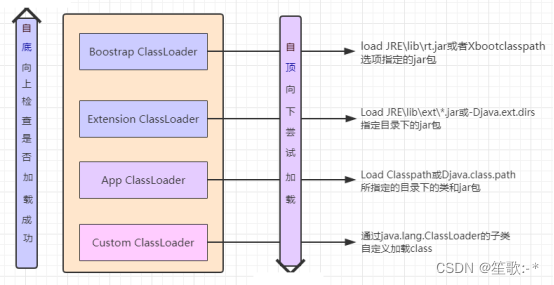
-
*Bootstrap ClassLoader* 最顶层的加载类,主要加载核心类库,%JRE_HOME%\lib下的rt.jar、resources.jar、charsets.jar和class等;
Bootstrap ClassLoader是C语言实现的;
-
*Extention ClassLoader* 扩展的类加载器,加载目录%JRE_HOME%\lib\ext目录下的jar包和class文件;
-
****Appclass Loader****也称为SystemAppClass 加载当前应用的classpath下的所有类;
-
那么这3个类加载器的加载顺序是怎么样的,具体哪个先行?顺序是:
-
Bootstrap CLassloder
-
Extention ClassLoader
-
AppClassLoader
-
-
我们自己写的类是由AppClassLoader加载,jdk api提供的那些类,比如String,Object,Date是由Bootstrap CLassloder加载;
System.out.println(Test.class.getClassLoader());
System.out.println(String.class.getClassLoader());
每个类加载器都有一个父加载器,比如加载Test.class是由AppClassLoader完成,那么AppClassLoader也有一个父加载器,通过getParent方法获取;
ClassLoader cl = Test.class.getClassLoader();
System.out.println("ClassLoader is:"+cl.toString());
System.out.println("ClassLoader's parent is:"+cl.getParent());
System.out.println("ClassLoader's parent is:"+cl.getParent().getParent());
ExtClassLoader的父加载器是null(因为是C语言实现的,所以打不出名字);
双亲委派机制 第一次加载往上
先让1加载 找不到2 然后3
如果自己写了string 类不会用自己的 。
类加载时期
- 当类加载器将类加载到JVM中的时候就会创建静态变量,这跟对象是否创建无关。静态变量加载的时候就会分配内存空间。静态代码块的代码只会在类第一次初始化的时候执行一次。一个类可以有多个静态代码块,它并不是类的成员,也没有返回值,并且不能直接调用。静态代码块不能包含this或者super,它们通常被用初始化静态变量。
- 静态代码块->静态成员变量->构造方法
Mybatis
1、读取mybatis-config.xml配置文件
第一步:读取mybatis-config.xml配置文件**
*InputStream inputStream = Resources.getResourceAsStream(“mybatis-config.xml”);
通过Resources工具类,调用ClassLoader读取classpath下的mybatis-config.xml配置文件,得到一个输入流;
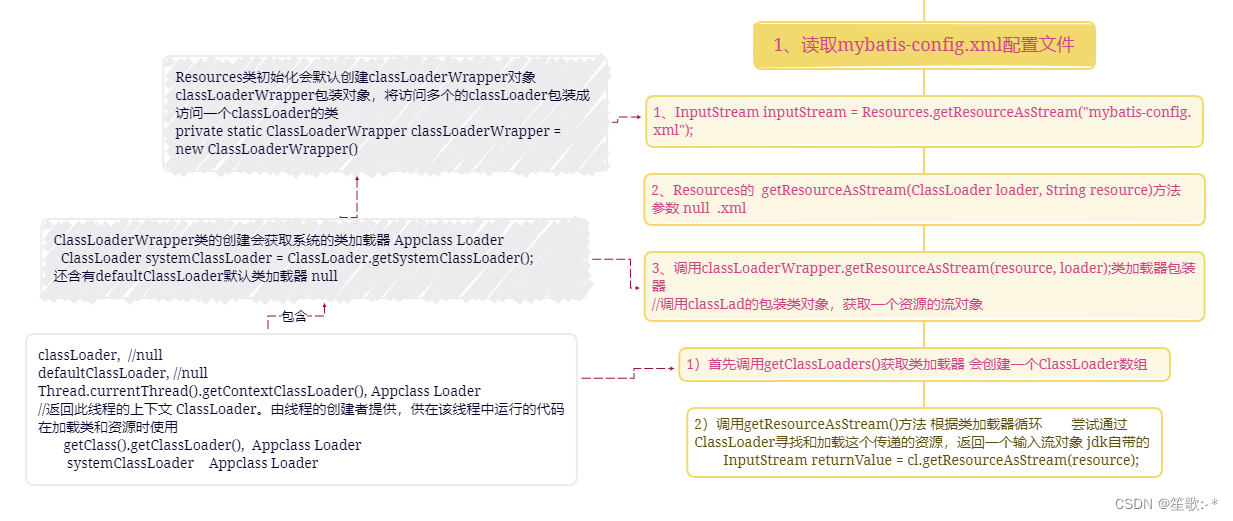

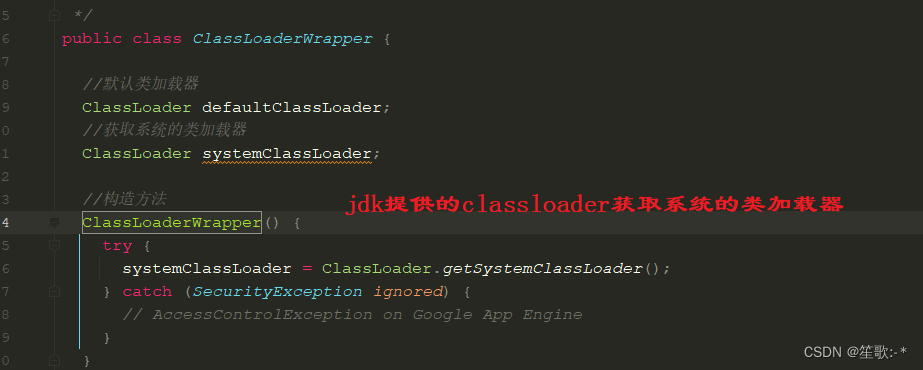


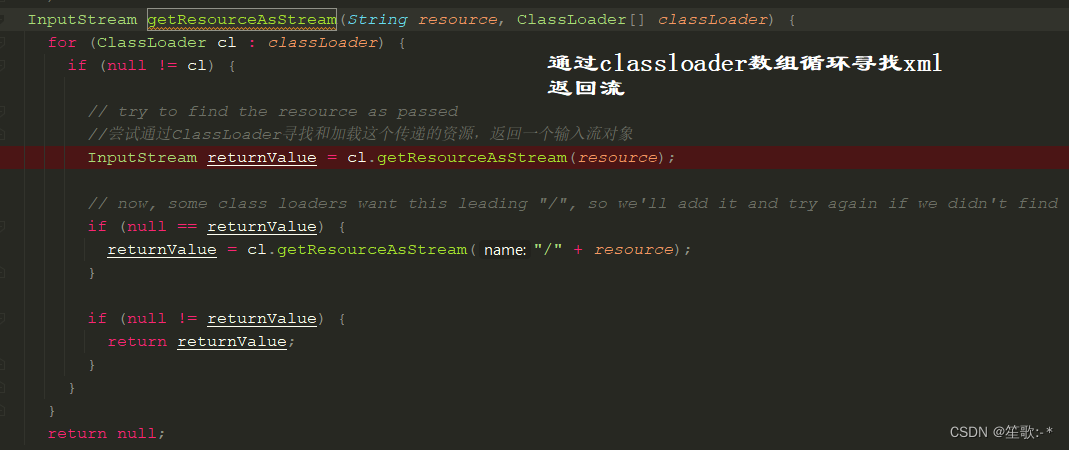
2、构建SqlSessionFactory
-
xmlConfigBuilder xml配置构建器对象
1、创建XPathParser对象 1)创建 XPath解析器对象,2)创建文档对象document
2、XMLConfigBuilder继承父类,调用时:其构造法方法中创建一个核心配置类Configuration配置类对象(mybatis-config.xml)。
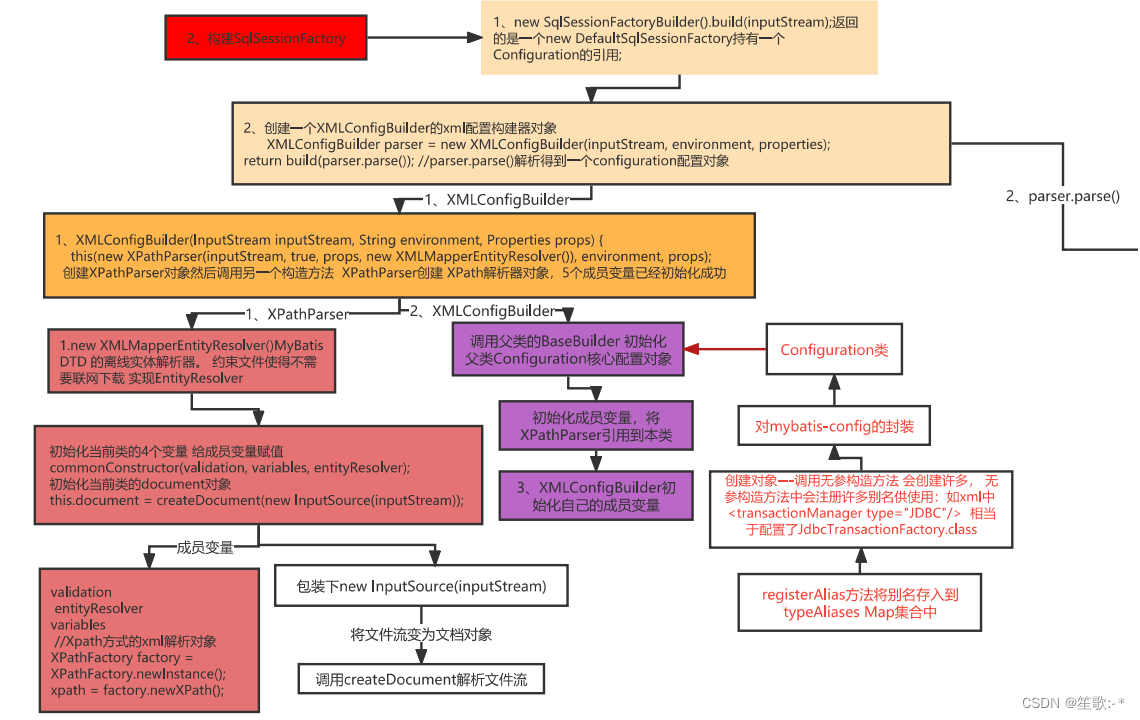
-
构建SqlSessionFactory
SqlSessionFactory sqlSessionFactory = new SqlSessionFactoryBuilder().build(inputStream); -
1、创建一个SqlSessionFactoryBuilder对象:
new SqlSessionFactoryBuilder(); 什么都没干
-
2、调用SqlSessionFactoryBuilder对象的build方法:
build(InputStream inputStream)
-

-
3、创建XMLConfigBuilder 对象:
XMLConfigBuilder parser = new XMLConfigBuilder(inputStream, environment, properties);

-
4、创建XMLMapperEntityResolver对象:
new XMLMapperEntityResolver()

-
5、创建XPathParser对象:
new XPathParser(inputStream, true, props, new XMLMapperEntityResolver())
**第二步:**创建InputSource将文件流变为文档流

-
6、创建XPath对象:
XPathFactory factory = XPathFactory.newInstance();
this.xpath = factory.newXPath();
变量值:true , null , null

-
7、创建Document对象:(DOM解析)
//JDK提供的文档解析工厂对象
DocumentBuilderFactory factory = DocumentBuilderFactory.*newInstance*();
*//**创建一个**DocumentBuilder**对象***
DocumentBuilder builder = factory.newDocumentBuilder();
//**解析输入源的**xml**数据为一个**Document**文件***
**return** builder.parse(inputSource);
//解析文件流转为Document
private Document createDocument(InputSource inputSource) {
// important: this must only be called AFTER common constructor
try {
//jdk提供的文档解析工厂对象
DocumentBuilderFactory factory = DocumentBuilderFactory.newInstance();
factory.setFeature(XMLConstants.FEATURE_SECURE_PROCESSING, true);
//设置是否验证
factory.setValidating(validation);
//是否支持命名空间
factory.setNamespaceAware(false);
//设置是否忽略注释
factory.setIgnoringComments(true);
// 设置是否忽略元素内容的空白
factory.setIgnoringElementContentWhitespace(false);
//是否将CDATA节点转化为文本节点
factory.setCoalescing(false);
//设置是否展开实体引用节点,sql片段的引用
factory.setExpandEntityReferences(true);
//创建一个DocumentBuilder对象
DocumentBuilder builder = factory.newDocumentBuilder();
//设置解析mybatis xml文档节点实体解析器 XMLMapperEntityResolver 验证xml文件是否合法
builder.setEntityResolver(entityResolver);
//设置解析文档错误的处理
builder.setErrorHandler(new ErrorHandler() {
@Override
public void error(SAXParseException exception) throws SAXException {
throw exception;
}
@Override
public void fatalError(SAXParseException exception) throws SAXException {
throw exception;
}
@Override
public void warning(SAXParseException exception) throws SAXException {
// NOP
}
});
//解析输入源的xml数据为一个**Document**文件
return builder.parse(inputSource);
} catch (Exception e) {
throw new BuilderException("Error creating document instance. Cause: " + e, e);
}
}
-
8、创建Configuration对象
1、调用父类的BaseBuilder 初始化父类Configuration核心配置对象

new Configuration()注册类型别名初始化Configuration对象的一些成员变量的默认值


无参构造方法中会注册许多别名供使用:registerAlias() 方法将别名存入到typeAliases Map集合中
类加载时:

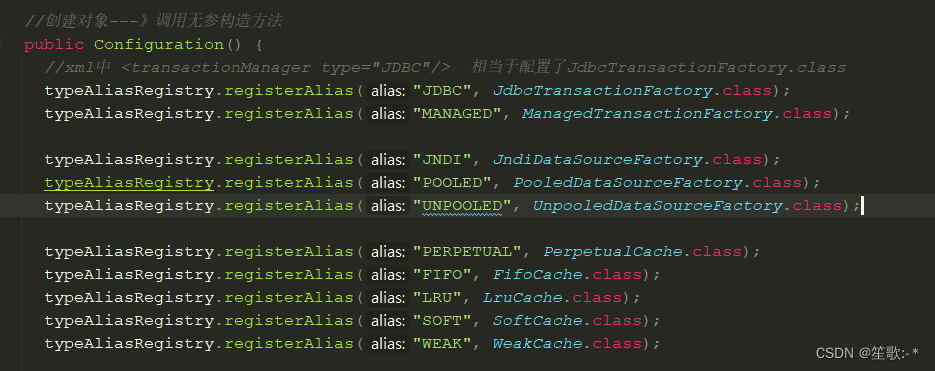


-
解析xml 利用 XPath解析器对象,文档对象document
XNode含有当前类对象XPathParser、node。
解析过后的数据放入到Configuration


- parser.parse()

-
9、通过XPath方法解析mybatis-config.xml文件:
parseConfiguration(parser.evalNode(“/configuration”));
将解析出来的信息封装到Configuration对象中;
- parser.evalNode(“/configuration”)
- 1)Node node = (Node) evaluate(expression, root, XPathConstants.NODE[命名空间]);
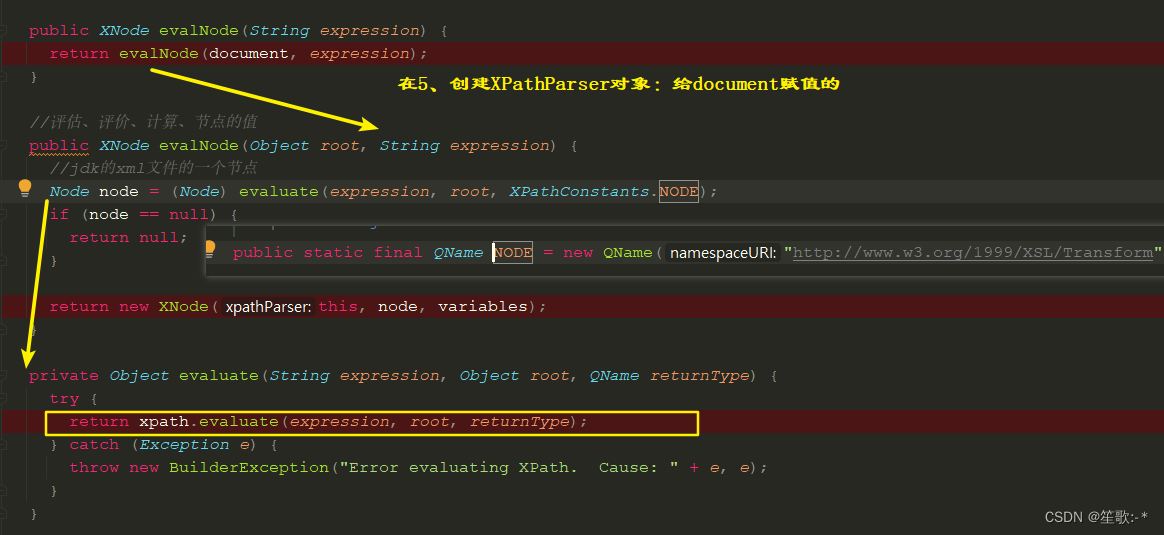
- 1)Node node = (Node) evaluate(expression, root, XPathConstants.NODE[命名空间]);
- parser.evalNode(“/configuration”)

2)return new XNode(this, node, variables);

- **parseConfiguration(XNode)** 解析xml文件
会返回父类中的核心配置类 **上述8**

- 如 :environmentsElement(root.evalNode("**environments**"));

- 继续上述中的**parser**.evalNode(**"/configuration"**)

- environmentsElement(xnode)解析
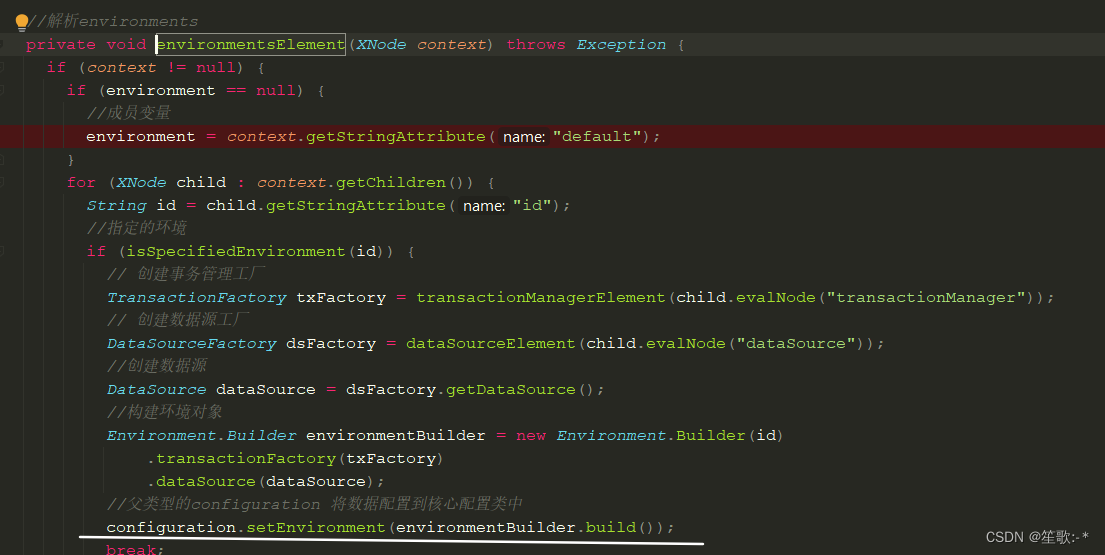
-
10、build()
通过持有Configuration对象创建一个DefaultSqlSessionFactory对象:
new DefaultSqlSessionFactory(configuration);

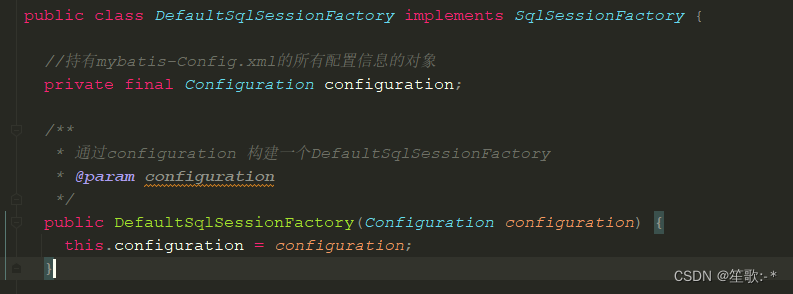
3、打开SqlSession
//第三步:
SqlSession session = sqlSessionFactory.openSession();
1、从configuration配置对象中获取环境environment信息;
2、根据环境environment信息获取事务工厂TransactionFactory;
3、根据环境信息中创建一个事务对象Transaction(会打开jdbc连接);
4、根据configuration和Transaction创建一个执行器Executor对象;
5、根据configuration和Executor(进行jdbc调用数据库操作)创建一个默认的SqlSession对象;
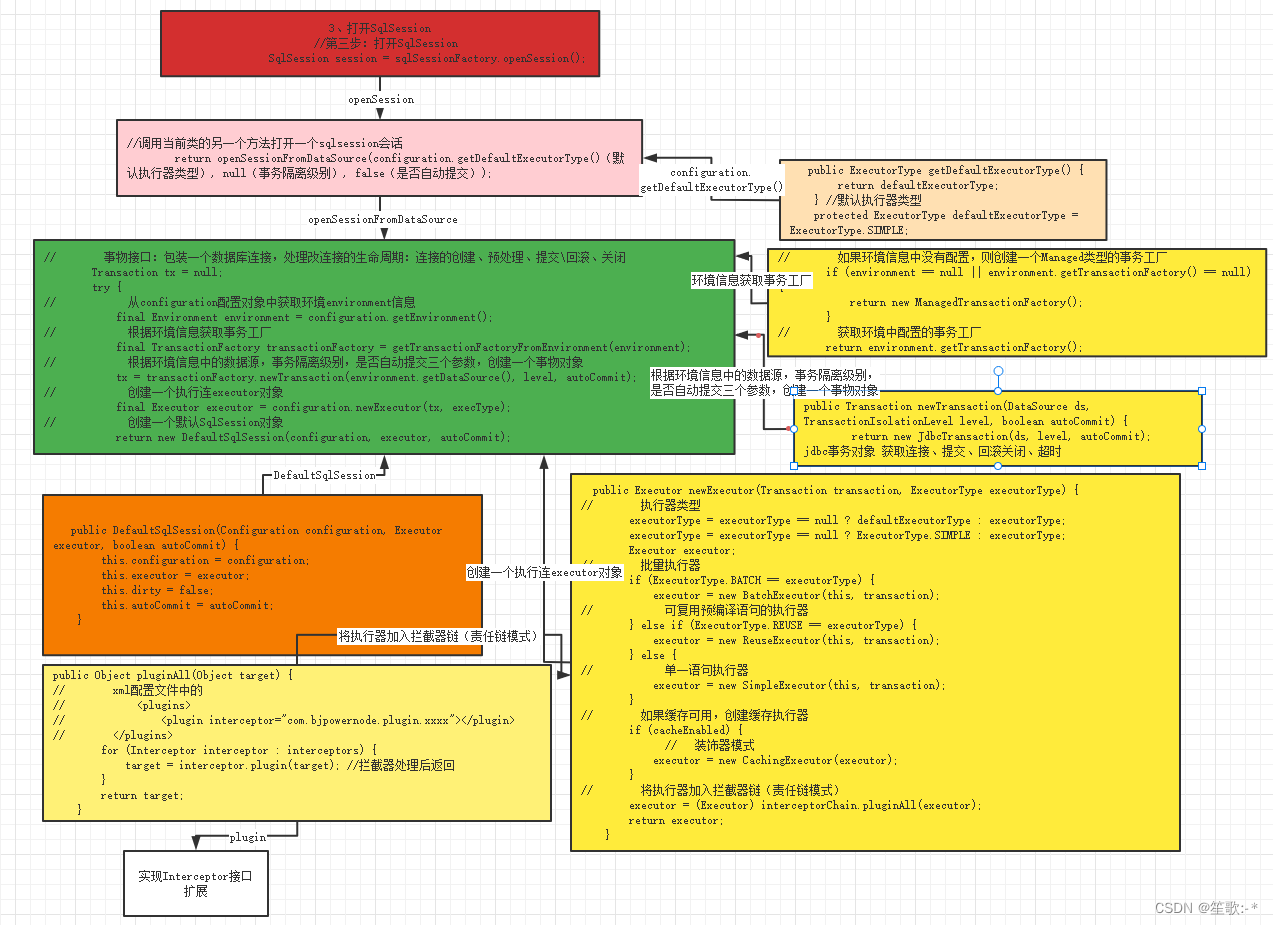
openSessionFromDataSource(configuration.getDefaultExecutorType()(默认执行器类型), null(事务隔离级别), false(是否自动提交));

- 默认执行器类型

-
private SqlSession openSessionFromDataSource(ExecutorType execType, TransactionIsolationLevel level, boolean autoCommit) { // 事物接口:包装一个数据库连接,处理改连接的生命周期:连接的创建、预处理、提交\回滚、关闭 Transaction tx = null; try { // 从configuration配置对象中获取环境environment信息 final Environment environment = configuration.getEnvironment(); // 根据环境信息获取事务工厂 final TransactionFactory transactionFactory = getTransactionFactoryFromEnvironment(environment); // 根据环境信息中的数据源,事务隔离级别,是否自动提交三个参数,创建一个事物对象 tx = transactionFactory.newTransaction(environment.getDataSource(), level, autoCommit); // 创建一个执行链executor对象 final Executor executor = configuration.newExecutor(tx, execType); // 创建一个默认SqlSession对象 return new DefaultSqlSession(configuration, executor, autoCommit); } catch (Exception e) { // 关闭事务对象 closeTransaction(tx); // may have fetched a connection so lets call close() throw ExceptionFactory.wrapException("Error opening session. Cause: " + e, e); } finally { // 重置错误上下文 ErrorContext.instance().reset(); } } -
根据环境信息获取事务工厂
final TransactionFactory transactionFactory = getTransactionFactoryFromEnvironment(environment);

-
根据环境信息中的数据源,事务隔离级别,是否自动提交三个参数,创建一个事物对象
tx = transactionFactory.newTransaction(environment.getDataSource(), level, autoCommit);
jdbc事务对象 获取连接、提交、回滚关闭、超时

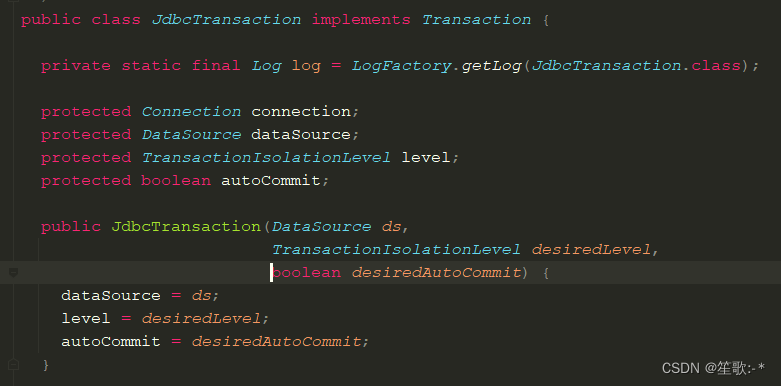

-
创建一个执行链executor对象 executorType :默认执行器类型
final Executor executor = configuration.newExecutor(tx, execType);public Executor newExecutor(Transaction transaction, ExecutorType executorType) { // 执行器类型 executorType = executorType == null ? defaultExecutorType : executorType; executorType = executorType == null ? ExecutorType.SIMPLE : executorType; Executor executor; // 批量执行器 if (ExecutorType.BATCH == executorType) { executor = new BatchExecutor(this, transaction); // 可复用预编译语句的执行器 } else if (ExecutorType.REUSE == executorType) { executor = new ReuseExecutor(this, transaction); } else { // 单一语句执行器 executor = new SimpleExecutor(this, transaction); } // 如果缓存可用,创建缓存执行器 if (cacheEnabled) { executor = new CachingExecutor(executor); } // 将执行器加入拦截器链 executor = (Executor) interceptorChain.pluginAll(executor); return executor; }
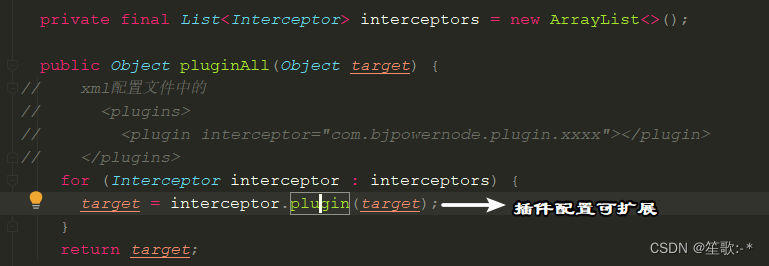
- 创建一个默认SqlSession对象 持有configuration核心配置类 executor执行器
return new DefaultSqlSession(configuration, executor, autoCommit);

4、获取Mapper接口对象 (底层是动态代理)
//第四步:
AccountMapper accountMapper = session.getMapper(AccountMapper.class);
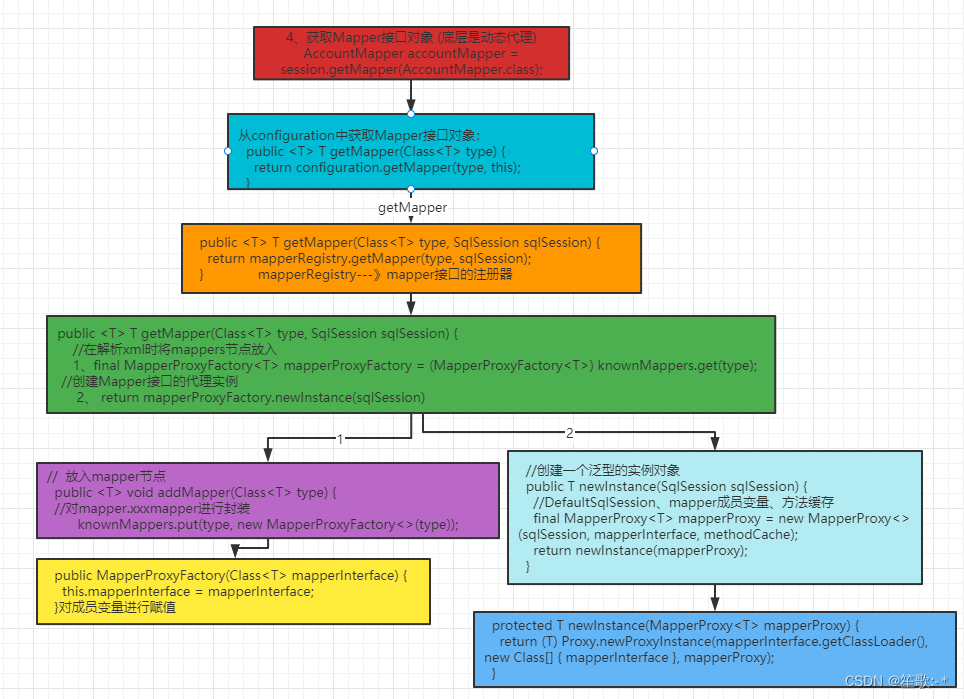
1、从configuration中获取Mapper接口对象;
@Override
public <T> T getMapper(Class<T> type) {
return configuration.getMapper(type, this);
}
this当前类也就是DefaultSqlSession
-
2、mapper接口的注册器 MapperRegistry 在构建SqlSessionFactory时初始化

-
3、包装接口引用时将mapper(dao)层放入map中
knownMappers.get(mapper.class)获取到包装的com.xxx.mapper.xxxMapper
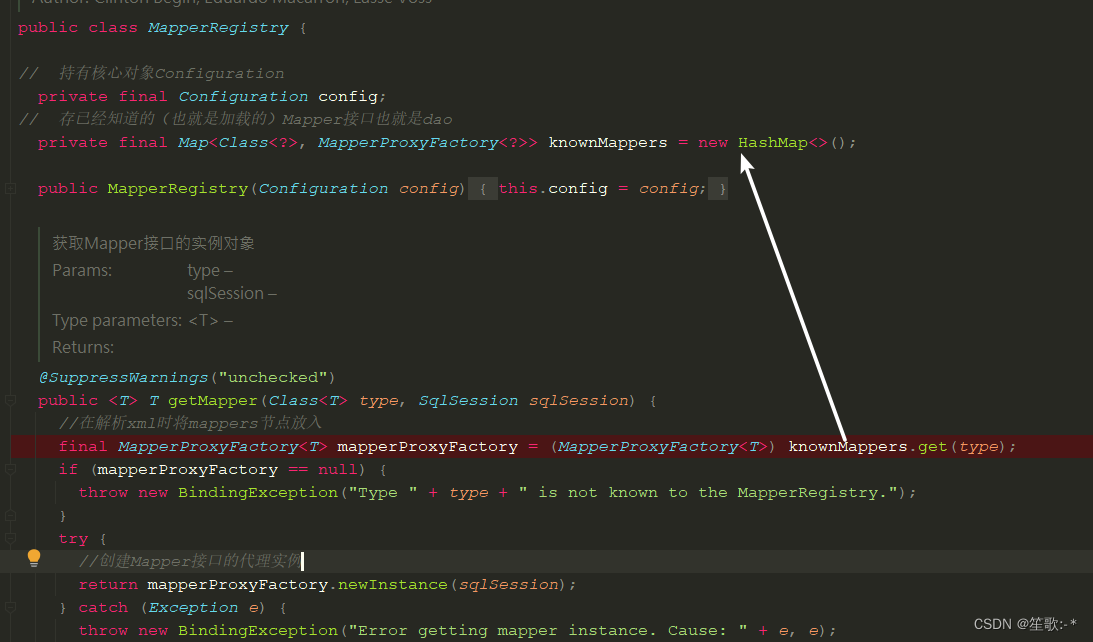
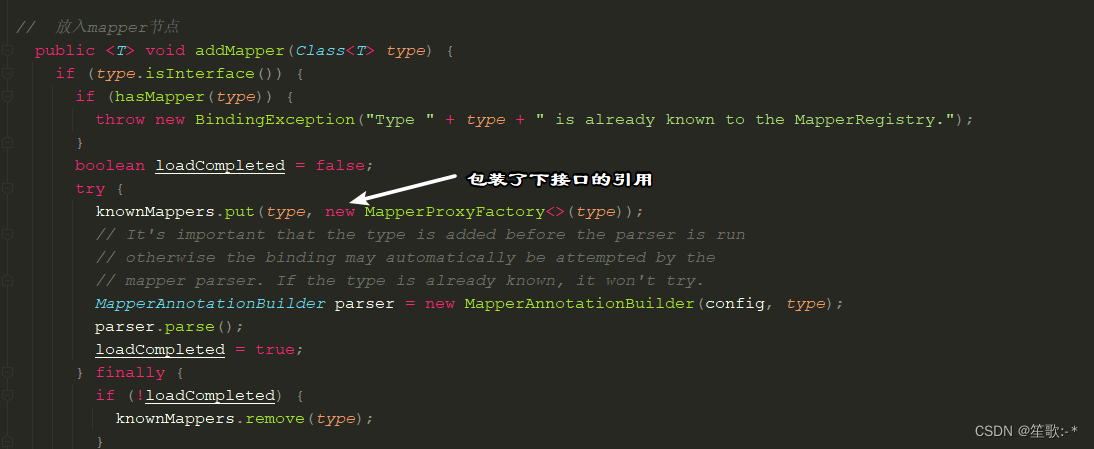
-
4、knownMappers.put(type, new MapperProxyFactory<>(type)); //给MapperProxyFactory的成员变量赋值 //mapper接口class com.xxx.xxx.mapper.xxxMapper private final Class<T> mapperInterface; public MapperProxyFactory(Class<T> mapperInterface) { this.mapperInterface = mapperInterface; } -
5、创建Mapper接口的代理实例 mapperProxyFactory.newInstance(sqlSession); public class MapperProxyFactory<T> { //mapper接口class com.xxx.xxx.mapper.xxxMapper private final Class<T> mapperInterface; //方法缓存 0 private final Map<Method, MapperMethodInvoker> methodCache = new ConcurrentHashMap<>(); public MapperProxyFactory(Class<T> mapperInterface) { this.mapperInterface = mapperInterface; } public Class<T> getMapperInterface() { return mapperInterface; } public Map<Method, MapperMethodInvoker> getMethodCache() { return methodCache; } //动态代理 @SuppressWarnings("unchecked") protected T newInstance(MapperProxy<T> mapperProxy) { return (T) Proxy.newProxyInstance(mapperInterface.getClassLoader(), new Class[] { mapperInterface }, mapperProxy); } //创建一个泛型的实例对象 public T newInstance(SqlSession sqlSession) { //DefaultSqlSession、mapper成员变量、方法缓存 MapperProxy类使用 final MapperProxy<T> mapperProxy = new MapperProxy<>(sqlSession, mapperInterface, methodCache); return newInstance(mapperProxy); }

- Proxy.newProxyInstance(mapperInterface.getClassLoader(), new Class[] { mapperInterface }, mapperProxy);
- 进行动态代理
1、静态代理
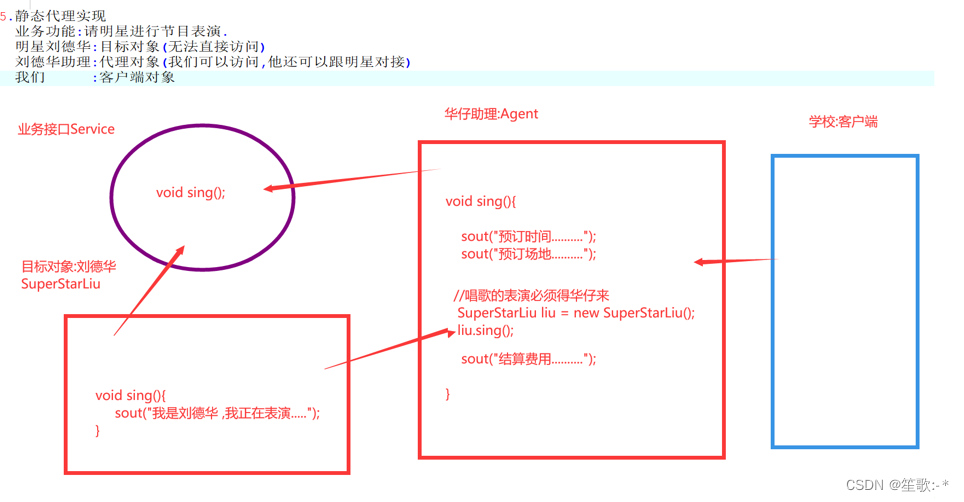
2、动态代理
1、JDK动态代理
1)目标对象必须实现业务接口
2)JDK代理对象不需要实现业务接口
3)JDK动态代理的对象在程序运行前不存在.在程序运行时动态的在内存中构建
4)JDK动态代理灵活的进行业务功能的切换
5)本类中的方法(非接口中的方法)不能被代理
//1、jvm内存中生成一个class类;
//2、根据该class类反射创建一个代理对象 $Proxy@564546548
- JDK动态代理用到的类和接口 它是使用现在的工具类完成JDK动态实现.
Proxy类 它是java.lang.reflect.Proxy包下的类. 它有一个方法Proxy.newProxyInstance(…)专门用来生成动态代理对象.
public static Object newProxyInstance(ClassLoader loader, //类加载器
Class<?>[] interfaces,//目标对象实现的所有接口
InvocationHandler h //它就类似于Agent的功能,代理的功能和目标对象的业务功能调用在这
)
throws IllegalArgumentException
{...}
Method类 反射用的类,用来进行目标对象的方法的反射调用.
method对象接住我们正在调用的方法sing(),show()
method==sing(),show()
method.invoke();==>手工调用目标方法 sing(); show();
InvocationHandler接口 它是实现代理和业务功能的.我们在调用时使用匿名内部实现.
代码实现:
public class ProxyFactory {
//类中的成员变量设计为接口,目标对象
Service target;
//传入目标对象
public ProxyFactory(Service target){
this.target = target;
}
//返回动态代理对象
public Object getAgent(){
return Proxy.newProxyInstance(
//ClassLoader loader, 类加载器,完成目标对象的加载
target.getClass().getClassLoader(),
//Class<?>[] interfaces,目标对象实现的所有接口
target.getClass().getInterfaces(),
//InvocationHandler h,实现代理功能的接口 ,我们传入的是匿名内部实现
new InvocationHandler() {
@Override
public Object invoke(
//创建代理对象
Object proxy,
//method就是目标方法sing(),show()
Method method,
//目标方法的参数
Object[] args) throws Throwable {
//代理功能
System.out.println("预订时间........");
//代理功能
System.out.println("预订场地........");
//主业务功能实现
//target.sing();还是写死了方法的调用, 不成
//sing(),show(),one()
Object obj = method.invoke(target,args);
//代理功能
System.out.println("结算费用........");
return obj; //切记:这个是目标方法的返回值
}
}
);
}
//保存生成的代理类文件
System.setProperty("sun.misc.ProxyGenerator.saveGeneratedFiles", "true");
}
2、CGLib动态代理
又称为子类.通过动态的在内存中构建子类对象,重写父类的方法进行代理功能的增强.
如果目标对象没有实现接口,则只能通过CGLib子类代理来进行功能增强.
子类代理是对象字节码框架ASM来实现的.
注意:
被代理的类不能为final, 否则报错.
目标对象的方法如果为final/static, 那么就不会被拦截,即不会执行目标对象额外的业务方法。
public Object getProxyInstance(){
//1.使用工具类
Enhancer en=new Enhancer();
//2.设置父类
en.setSuperclass(target.getClass());
//3.设置回调函数
en.setCallback(this);
//4.创建子类(代理)对象
return en.create(); ===>返回的是子类代理对象
5、调用Mapper接口对象的方法操作数据库;
Account account = accountMapper.selectByPrimaryKey(41);
- 会动态调用MapperProxy的invoke方法
public Object invoke(Object proxy, Method method, Object[] args) throws Throwable {
//得到方法所在的类如果时Object,直接调用,不做拦截处理
1、if (Object.class.equals(method.getDeclaringClass())) {
return method.invoke(this, args);
//调用接口的默认方法
} else {
2、return cachedInvoker(method).invoke(proxy, method, args, sqlSession);
}
1、如果传进来的是Object对象,则直接执行本对象的自己的方法,并非mapper对象接口中的方法如:toString()等
if (Object.class.equals(method.getDeclaringClass())) {
return method.invoke(this, args)
2、cachedInvoker sql映射
会进行缓存 将数据缓存到methodCache
注意:map的computeIfAbsent
如果给定的key不存在(或者key对应的value为null),就去计算mappingFunction的值;
如果mappingFunction的值不为null,就把key=value放进去;
如果mappingFunction的值为null,就不会记录该映射关系,返回值为null;
如果计算mappingFunction的值的过程出现异常,再次抛出异常,不记录映射关系,返回null;
如果存在该key,并且key对应的value部位null,返回null;
//在第四部分的第5步:创建Mapper接口的代理实例会传一个 methodCache方法缓存
private MapperMethodInvoker cachedInvoker(Method method) throws Throwable {
try {
//Map<K, V> map, K key, Function<K, V> mappingFunction
//methodCache是获取在Mapper接口对象(MapperProxyFactory)中赋值的
//method: public abstract com.bjpowernode.model.Account
// com.bjpowernode.mapper.AccountMapper.selectByPrimaryKey(java.lang.Integer)
//m-> : 映射函数 会将MapperMethod绑定到方法缓存中
return MapUtil.computeIfAbsent(methodCache, method, m -> {
if (m.isDefault()) { //false 判断此方法是否是默认实现的
try {
if (privateLookupInMethod == null) {
return new DefaultMethodInvoker(getMethodHandleJava8(method));
} else {
return new DefaultMethodInvoker(getMethodHandleJava9(method));
}
} catch (IllegalAccessException | InstantiationException | InvocationTargetException
| NoSuchMethodException e) {
throw new RuntimeException(e);
}
} else {
//关键构造MapperMethod类 也就是目标对象
return new PlainMethodInvoker(new MapperMethod(mapperInterface, method, sqlSession.getConfiguration()));
}
});
} catch (RuntimeException re) {
Throwable cause = re.getCause();
throw cause == null ? re : cause;
}
}
1、获得一个MapperMethod(执行代理增强功能的类)
new MapperMethod(mapperInterface, method, sqlSession.getConfiguration())
在mapperMethod中有两个成员变量 静态内部类:
SqlCommand command 对应mapper.xml的sql语句
MethodSignature method 对应mapper.java接口的方法(f返回值,类型等)
public class MapperMethod {
//sql命令 主要含有name = ms.getId(); com.bjpowernode.mapper.AccountMapper.selectByPrimaryKey
// type = ms.getSqlCommandType(); selsct 类型 什么语句
private final SqlCommand command;
//方法签名
private final MethodSignature method;
/**
* 根据Mapper接口类型、接口方法、核心配置对象 构造MapperMethod对象
*
* @param mapperInterface mapper接口
* @param method 调用的方法
* @param config 配置类
*/
public MapperMethod(Class<?> mapperInterface, Method method, Configuration config) {
this.command = new SqlCommand(config, mapperInterface, method);
this.method = new MethodSignature(config, mapperInterface, method);
}
1)this.command = new SqlCommand(config, mapperInterface, method);
MappedStatement含有sql的所有信息
public SqlCommand(Configuration configuration, Class<?> mapperInterface, Method method) {
//获取方法名
final String methodName = method.getName();
//方法所在的类是那个类
final Class<?> declaringClass = method.getDeclaringClass();
//解析得到mapper语句对象
MappedStatement ms = resolveMappedStatement(mapperInterface, methodName, declaringClass,
configuration);
if (ms == null) {
if (method.getAnnotation(Flush.class) != null) {
name = null;
type = SqlCommandType.FLUSH;
} else {
throw new BindingException("Invalid bound statement (not found): "
+ mapperInterface.getName() + "." + methodName);
}
} else {
name = ms.getId(); //com.bjpowernode.mapper.AccountMapper.selectByPrimaryKey
type = ms.getSqlCommandType(); //selsct 类型 什么语句
if (type == SqlCommandType.UNKNOWN) {
throw new BindingException("Unknown execution method for: " + name);
}
}
}
-
解析得到mapper语句对象
MappedStatement ms = resolveMappedStatement(mapperInterface, methodName, declaringClass,configuration);
private MappedStatement resolveMappedStatement(Class<?> mapperInterface, String methodName,
Class<?> declaringClass, Configuration configuration) {
//接口的包名+接口的方法名=sql的id
//statementId == com.bjpowernode.mapper.AccountMapper.selectByPrimaryKey
String statementId = mapperInterface.getName() + "." + methodName;
if (configuration.hasStatement(statementId)) {
return configuration.getMappedStatement(statementId);
} else if (mapperInterface.equals(declaringClass)) {
return null;
}
for (Class<?> superInterface : mapperInterface.getInterfaces()) {
if (declaringClass.isAssignableFrom(superInterface)) {
MappedStatement ms = resolveMappedStatement(superInterface, methodName,
declaringClass, configuration);
if (ms != null) {
return ms;
}
}
}
return null;
}
}
-
configuration.getMappedStatement(statementId);
在核心配置类创建时初始化MappedStatement对象
//configuration核心配置类
public MappedStatement getMappedStatement(String id) {
return this.getMappedStatement(id, true);
}
public MappedStatement getMappedStatement(String id, boolean validateIncompleteStatements) {
if (validateIncompleteStatements) {
buildAllStatements();
}
return mappedStatements.get(id);
}
2)this.method = new MethodSignature(config, mapperInterface, method);
public MethodSignature(Configuration configuration, Class<?> mapperInterface, Method method) {
//返回类型resolvedReturnType 赋值给这个静态内部类的成员变量
Type resolvedReturnType = TypeParameterResolver.resolveReturnType(method, mapperInterface);
if (resolvedReturnType instanceof Class<?>) {
this.returnType = (Class<?>) resolvedReturnType;
} else if (resolvedReturnType instanceof ParameterizedType) {
this.returnType = (Class<?>) ((ParameterizedType) resolvedReturnType).getRawType();
} else {
this.returnType = method.getReturnType();
}
this.returnsVoid = void.class.equals(this.returnType);
this.returnsMany = configuration.getObjectFactory().isCollection(this.returnType) || this.returnType.isArray();
this.returnsCursor = Cursor.class.equals(this.returnType);
this.returnsOptional = Optional.class.equals(this.returnType);
this.mapKey = getMapKey(method);
this.returnsMap = this.mapKey != null;
this.rowBoundsIndex = getUniqueParamIndex(method, RowBounds.class);
this.resultHandlerIndex = getUniqueParamIndex(method, ResultHandler.class);
this.paramNameResolver = new ParamNameResolver(configuration, method);
}
2、new PlainMethodInvoker(MapperMethod) 最终执行MapperMethod执行代理增强功能的类
执行具体的查询语句
//MapperProxy类中的接口以及实现
//将MapperMethod包装到MapperMethodInvoker中
interface MapperMethodInvoker {
Object invoke(Object proxy, Method method, Object[] args, SqlSession sqlSession) throws Throwable;
}
private static class PlainMethodInvoker implements MapperMethodInvoker {
private final MapperMethod mapperMethod;
public PlainMethodInvoker(MapperMethod mapperMethod) {
super();
this.mapperMethod = mapperMethod;
}
@Override
public Object invoke(Object proxy, Method method, Object[] args, SqlSession sqlSession) throws Throwable {
return mapperMethod.execute(sqlSession, args);
}
}
3.invoke(proxy, method, args, sqlSession);
//首先调用MapperMethodInvoker的invoke
//mapperMethod.execute(sqlSession, args);
public Object execute(SqlSession sqlSession, Object[] args) {
Object result;
//判断类型
switch (command.getType()) {
case INSERT: { //添加
Object param = method.convertArgsToSqlCommandParam(args);
result = rowCountResult(sqlSession.insert(command.getName(), param));
break;
}
case UPDATE: { //更新
Object param = method.convertArgsToSqlCommandParam(args);
result = rowCountResult(sqlSession.update(command.getName(), param));
break;
}
case DELETE: { //删除
Object param = method.convertArgsToSqlCommandParam(args);
result = rowCountResult(sqlSession.delete(command.getName(), param));
break;
}
case SELECT: //查询
//判断是否返回为空
if (method.returnsVoid() && method.hasResultHandler()) {
executeWithResultHandler(sqlSession, args);
result = null;
} else if (method.returnsMany()) { //判断是否多条数据
result = executeForMany(sqlSession, args);
} else if (method.returnsMap()) {
result = executeForMap(sqlSession, args);
} else if (method.returnsCursor()) { //游标
result = executeForCursor(sqlSession, args);
} else {
//参数转化,转成SqlCommand参数
Object param = method.convertArgsToSqlCommandParam(args);
//执行查询,查询单条数据
result = sqlSession.selectOne(command.getName(), param);
if (method.returnsOptional()
&& (result == null || !method.getReturnType().equals(result.getClass()))) {
result = Optional.ofNullable(result);
}
}
break;
case FLUSH:
result = sqlSession.flushStatements();
break;
default:
throw new BindingException("Unknown execution method for: " + command.getName());
}
if (result == null && method.getReturnType().isPrimitive() && !method.returnsVoid()) {
throw new BindingException("Mapper method '" + command.getName()
+ " attempted to return null from a method with a primitive return type (" + method.getReturnType() + ").");
}
return result;
}
- result = sqlSession.selectOne(command.getName(), param); DefaultSqlSession
public <T> T selectOne(String statement, Object parameter) {
// Popular vote was to return null on 0 results and throw exception on too many.
List<T> list = this.selectList(statement, parameter);
if (list.size() == 1) {
return list.get(0);
} else if (list.size() > 1) { //查询出的数据大于1抛出异常
throw new TooManyResultsException("Expected one result (or null) to be returned by selectOne(), but found: " + list.size());
} else {
return null;
}
}
public <E> List<E> selectList(String statement, Object parameter) {
return this.selectList(statement, parameter, RowBounds.DEFAULT);
}
public <E> List<E> selectList(String statement, Object parameter, RowBounds rowBounds) {
return selectList(statement, parameter, rowBounds, Executor.NO_RESULT_HANDLER(null));
}
//查询数据
private <E> List<E> selectList(String statement, Object parameter, RowBounds rowBounds, ResultHandler handler) {
// statement: com.bjpowernode.mapper.AccountMapper.selectByPrimaryKey === id
//方法的参数值 parameter : 1
try {
//configuration.getMappedStatement(statement);根据statement获取到对应的MappedStatement信息 包含sql语句
//上一步 1-1-1 就是configuration中的
MappedStatement ms = configuration.getMappedStatement(statement);
//rowbounds默认情况查多少数据 0-2147483647
//executor为第3步时候创建的执行连executor对象
return executor.query(ms, wrapCollection(parameter), rowBounds, handler);
} catch (Exception e) {
throw ExceptionFactory.wrapException("Error querying database. Cause: " + e, e);
} finally {
ErrorContext.instance().reset();
}
}
- executor.query(ms, wrapCollection(parameter), rowBounds, handler);
//CachingExecutor implements Executor {
public <E> List<E> query(MappedStatement ms, Object parameterObject, RowBounds rowBounds, ResultHandler resultHandler) throws SQLException {
//拿到sql语句
BoundSql boundSql = ms.getBoundSql(parameterObject);
//一级缓存的key生成
CacheKey key = createCacheKey(ms, parameterObject, rowBounds, boundSql);
return query(ms, parameterObject, rowBounds, resultHandler, key, boundSql);
}
@Override
public <E> List<E> query(MappedStatement ms, Object parameterObject, RowBounds rowBounds, ResultHandler resultHandler, CacheKey key, BoundSql boundSql)
throws SQLException {
// 检查是否开启了二级缓存,即是否存在对应Mapper.xml的二级缓存对象
Cache cache = ms.getCache();
if (cache != null) {
flushCacheIfRequired(ms);
if (ms.isUseCache() && resultHandler == null) {
ensureNoOutParams(ms, boundSql);
@SuppressWarnings("unchecked")
List<E> list = (List<E>) tcm.getObject(cache, key);
if (list == null) {
list = delegate.query(ms, parameterObject, rowBounds, resultHandler, key, boundSql);
tcm.putObject(cache, key, list); // issue #578 and #116
}
return list;
}
}
//BaseExecutor的query
return delegate.query(ms, parameterObject, rowBounds, resultHandler, key, boundSql);
}
- return delegate.query(ms, parameterObject, rowBounds, resultHandler, key, boundSql);
//BaseExecutor implements Executor
//模板模式 抽象类 无具体实现
public <E> List<E> query(MappedStatement ms, Object parameter, RowBounds rowBounds, ResultHandler resultHandler, CacheKey key, BoundSql boundSql) throws SQLException {
ErrorContext.instance().resource(ms.getResource()).activity("executing a query").object(ms.getId());
if (closed) {
throw new ExecutorException("Executor was closed.");
}
if (queryStack == 0 && ms.isFlushCacheRequired()) {
clearLocalCache();
}
List<E> list;
try {
queryStack++;
// 结果处理器为null时,尝试从一级缓存获取已缓存结果
list = resultHandler == null ? (List<E>) localCache.getObject(key) : null;
if (list != null) { //缓存
handleLocallyCachedOutputParameters(ms, key, parameter, boundSql);
} else {
//从数据库查数据
list = queryFromDatabase(ms, parameter, rowBounds, resultHandler, key, boundSql);
}
} finally {
queryStack--;
}
if (queryStack == 0) {
for (DeferredLoad deferredLoad : deferredLoads) {
deferredLoad.load();
}
// issue #601
deferredLoads.clear();
if (configuration.getLocalCacheScope() == LocalCacheScope.STATEMENT) {
// issue #482
clearLocalCache();
}
}
return list;
}
//从数据库中查数据
private <E> List<E> queryFromDatabase(MappedStatement ms, Object parameter, RowBounds rowBounds, ResultHandler resultHandler, CacheKey key, BoundSql boundSql) throws SQLException {
List<E> list;
// 一级缓存,使用key添加一个一级缓存占位符
localCache.putObject(key, EXECUTION_PLACEHOLDER);
try {
//执行查询
list = doQuery(ms, parameter, rowBounds, resultHandler, boundSql);
} finally {
//清空
localCache.removeObject(key);
}
//加入
localCache.putObject(key, list);
if (ms.getStatementType() == StatementType.CALLABLE) {
localOutputParameterCache.putObject(key, parameter);
}
return list;
}
//list = doQuery(ms, parameter, rowBounds, resultHandler, boundSql);
//SimpleExecutor extends BaseExecutor
//JDBC
public <E> List<E> doQuery(MappedStatement ms, Object parameter, RowBounds rowBounds, ResultHandler resultHandler, BoundSql boundSql) throws SQLException {
Statement stmt = null;
try {
Configuration configuration = ms.getConfiguration();
//创建一个预编译的StatementHandler解析SQL语句
StatementHandler handler = configuration.newStatementHandler(wrapper, ms, parameter, rowBounds, resultHandler, boundSql);
// 预编译SQL
stmt = prepareStatement(handler, ms.getStatementLog(/*日志 settings*/));
// 执行查询
return handler.query(stmt, resultHandler);
} finally {
closeStatement(stmt);
}
}
- StatementHandler handler = configuration.newStatementHandler(wrapper, ms, parameter, rowBounds, resultHandler, boundSql)
创建一个预编译的 StatementHandler
/**
*
* @param executor 执行器
* @param mappedStatement sql封装的类
* @param parameterObject 参数
* @param rowBounds 默认情况查多少数据 0-2147483647
* @param resultHandler 结果
* @param boundSql sql语句
* @return
*/
public StatementHandler newStatementHandler(Executor executor, MappedStatement mappedStatement, Object parameterObject, RowBounds rowBounds, ResultHandler resultHandler, BoundSql boundSql) {
StatementHandler statementHandler = new RoutingStatementHandler(executor, mappedStatement, parameterObject, rowBounds, resultHandler, boundSql);
//责任链模式 按顺序执行 filtle典型的责任链设计模式 xml中的<plugin插件>
statementHandler = (StatementHandler) interceptorChain.pluginAll(statementHandler);
return statementHandler;
}
//StatementHandler statementHandler = new RoutingStatementHandler()
public RoutingStatementHandler(Executor executor, MappedStatement ms, Object parameter, RowBounds rowBounds, ResultHandler resultHandler, BoundSql boundSql) {
//策略模式 根据不同语句类型,选用不同的策略实现类 ms.getStatementType()解析xml时赋值
//初始化一些成员变量 根据 statementType 创建对应的 Statement 对象
/**
SimpleStatementHandler: 管理 Statement 对象并向数据库中推送不需要预编译的SQL语句
PreparedStatementHandler: 管理 Statement 对象并向数据中推送需要预编译的SQL语句,
CallableStatementHandler:管理 Statement 对象并调用数据库中的存储过程
*/
switch (ms.getStatementType()) {
case STATEMENT:
delegate = new SimpleStatementHandler(executor, ms, parameter, rowBounds, resultHandler, boundSql);
break;
case PREPARED:
delegate = new PreparedStatementHandler(executor, ms, parameter, rowBounds, resultHandler, boundSql);
break;
case CALLABLE:
delegate = new CallableStatementHandler(executor, ms, parameter, rowBounds, resultHandler, boundSql);
break;
default:
throw new ExecutorException("Unknown statement type: " + ms.getStatementType());
}
}
// new PreparedStatementHandler(executor, ms, parameter, rowBounds, resultHandler, boundSql);
//使用StatementHandler创建一个预编译的Statement
protected BaseStatementHandler(Executor executor, MappedStatement mappedStatement, Object parameterObject, RowBounds rowBounds, ResultHandler resultHandler, BoundSql boundSql) {
this.configuration = mappedStatement.getConfiguration();
this.executor = executor;
this.mappedStatement = mappedStatement;
this.rowBounds = rowBounds;
this.typeHandlerRegistry = configuration.getTypeHandlerRegistry();
this.objectFactory = configuration.getObjectFactory();
if (boundSql == null) { // issue #435, get the key before calculating the statement
generateKeys(parameterObject);
boundSql = mappedStatement.getBoundSql(parameterObject);
}
this.boundSql = boundSql;
//会加入插件拦截器
this.parameterHandler = configuration.newParameterHandler(mappedStatement, parameterObject, boundSql);
this.resultSetHandler = configuration.newResultSetHandler(executor, mappedStatement, rowBounds, parameterHandler, resultHandler, boundSql);
}
//jdbc
String sql="select * from student";//定义查询语句
Class.forName("com.mysql.jdbc.Driver");
//注册驱动程序,用java.lang包下面的class类里面的Class.froName();方法 此处的driver就是1里面定义的driver
Connection con=DriverManager.getConnection(dbUrl,dbUserName,dbPassword);
//获取数据库连接,使用java.sql里面的DriverManager的getConnectin(String url , String username ,String password )来完成
//构造一个statement对象来执行sql语句:主要有Statement,PreparedStatement,CallableStatement三种实例来实现
//三种实现方法分别为:Statement stmt = con.createStatement() ;
// PreparedStatement pstmt = conn.prepareStatement(sql) ;
//CallableStatement cstmt = conn.prepareCall("{CALL demoSp(? , ?)}") ;
Statement stmt=con.createStatement();
ResultSet rs=stmt.executeQuery(sql);//执行sql并返还结束 ;ResultSet executeQuery(String sqlString):用于返还一个结果集(ResultSet)对象。
//遍历结果集
while(rs.next()){
System.out.println("学生编号:"+rs.getInt("stuId")+",学生姓名:"+rs.getString("stuName")+",学生性别:"+rs.getString("stuSex")+",学生年龄:"+rs.getInt("stuAge"));//使用getString()方法获取你表里的资料名
jdbc底层封装 预编译SQL会进行连接 创建预编译 设置参数
预编译SQL会进行连接 创建预编译 设置参数
stmt = prepareStatement(handler, ms.getStatementLog(/*日志 settings*/));
-
创建连接:
-
1)使用在第3步创建的事务对象 (openSessionFromDataSource)获取连接
-
2)事务打开一个连接调用openConnection(); 掉用当前类的openConnection
-
3)方法中:dataSource.getConnection();会调用PooledDataSource类的getConnection :(PooledDataSource是mybatis的连接池)
//数据库的账号密码 getProxyConnection();返回一个代理类
popConnection(dataSource.getUsername(), dataSource.getPassword()).getProxyConnection(); -
4)PooledDataSource类的popConnection核心:
conn = new PooledConnection(dataSource.getConnection(), this);-
dataSource.getConnection() UnpooledDataSource 类 dataSource.getConnection()方法中会调用当前类的
doGetConnection(String username, String password)
是为了将用户名密码放入Properties 再调用当前类的doGetConnection(props); –>初始化驱动、获取连接、配置配置类
-
new PooledConnection对dataSource.getConnection()进行包装、成员变量初始化(还包括ProxyConnection代理对象) , 当前 PooledDataSource类
-
-
预编译: stmt = handler.prepare(connection, transaction.getTimeout()); 获取预编译的sql操作对象
return connection.prepareStatement(sql);
-
设置参数:handler.parameterize(stmt);
private Statement prepareStatement(StatementHandler handler, Log statementLog) throws SQLException {
Statement stmt;
//创建链接
Connection connection = getConnection(statementLog);
//预编译 return connection.prepareStatement(sql);
stmt = handler.prepare(connection, transaction.getTimeout());
//设置参数
handler.parameterize(stmt);
return stmt;
}
//创建链接 connection是一个代理对象
protected Connection getConnection(Log statementLog) throws SQLException {
Connection connection = transaction.getConnection(); //在第3步创建的事务对象 openSessionFromDataSource
if (statementLog.isDebugEnabled()) {//日志
return ConnectionLogger.newInstance(connection, statementLog, queryStack); //日志代理也是一个到动态代理, 一个代理对象可以被多次代理
} else {
return connection;
}
}
public Connection getConnection() throws SQLException {
openConnection();
return connection;
}
//事务打开一个连接调用openConnection(); 事务是在解析xml的环境时放入的
protected void openConnection() throws SQLException {
connection = dataSource.getConnection();//获取连接
setDesiredAutoCommit(autoCommit);//是否是自动提交
}
// PooledDataSource的getConnection()(mybatis的连接池 实现了InvocationHandler)
public Connection getConnection() throws SQLException {
//数据库的账号密码 getProxyConnection();返回一个代理类
return popConnection(dataSource.getUsername(), dataSource.getPassword()).getProxyConnection();
}
//PooledDataSource类的popConnection PooledConnection implements InvocationHandler
private PooledConnection popConnection(String username, String password) throws SQLException {
//核心
conn = new PooledConnection(dataSource.getConnection(), this);
return conn;
}
//UnpooledDataSource类dataSource.getConnection()
public Connection getConnection() throws SQLException {
return doGetConnection(username, password);
}
private Connection doGetConnection(String username, String password) throws SQLException {
//将用户名密码放入Properties
Properties props = new Properties();
if (driverProperties != null) {
props.putAll(driverProperties);
}
if (username != null) {
props.setProperty("user", username);
}
if (password != null) {
props.setProperty("password", password);
}
return doGetConnection(props);
}
// doGetConnection(props);
private Connection doGetConnection(Properties properties) throws SQLException {
initializeDriver();//初始化驱动
Connection connection = DriverManager.getConnection(url, properties); //获取连接
configureConnection(connection);//配置中会查看是否是自动提交、默认事务隔离级别、默认网络超时
return connection;
}
private synchronized void initializeDriver() throws SQLException {
if (!registeredDrivers.containsKey(driver)) {
Class<?> driverType;
try {
if (driverClassLoader != null) {
driverType = Class.forName(driver, true, driverClassLoader);
} else {
driverType = Resources.classForName(driver);
}
// DriverManager requires the driver to be loaded via the system ClassLoader.
// http://www.kfu.com/~nsayer/Java/dyn-jdbc.html
Driver driverInstance = (Driver) driverType.getDeclaredConstructor().newInstance();
//注册驱动
DriverManager.registerDriver(new DriverProxy(driverInstance));
registeredDrivers.put(driver, driverInstance);
} catch (Exception e) {
throw new SQLException("Error setting driver on UnpooledDataSource. Cause: " + e);
}
}
}
// configureConnection(connection);//配置中会查看是否是自动提交、默认事务隔离级别、默认网络超时
private void configureConnection(Connection conn) throws SQLException {
if (defaultNetworkTimeout != null) {
conn.setNetworkTimeout(Executors.newSingleThreadExecutor(), defaultNetworkTimeout);
}
if (autoCommit != null && autoCommit != conn.getAutoCommit()) {
conn.setAutoCommit(autoCommit);
}
if (defaultTransactionIsolationLevel != null) {
conn.setTransactionIsolation(defaultTransactionIsolationLevel);
}
}
//PooledConnection类
//new PooledConnection对dataSource.getConnection()进行包装、成员变量初始化,dataSource:当前 PooledDataSource类
public PooledConnection(Connection connection, PooledDataSource dataSource) {
this.hashCode = connection.hashCode();
this.realConnection = connection;
this.dataSource = dataSource;
this.createdTimestamp = System.currentTimeMillis();
this.lastUsedTimestamp = System.currentTimeMillis();
this.valid = true;
this.proxyConnection = (Connection) Proxy.newProxyInstance(Connection.class.getClassLoader(), IFACES, this);
}
//PooledConnection类的代理方法
public Object invoke(Object proxy, Method method, Object[] args) throws Throwable {
String methodName = method.getName();
//调用close方法会将连接放入连接池
if (CLOSE.equals(methodName)) {
dataSource.pushConnection(this);
return null;
}
try {
if (!Object.class.equals(method.getDeclaringClass())) {
// issue #579 toString() should never fail
// throw an SQLException instead of a Runtime
checkConnection();
}
return method.invoke(realConnection, args);
} catch (Throwable t) {
throw ExceptionUtil.unwrapThrowable(t);
}
}
private void checkConnection() throws SQLException {
if (!valid) {
throw new SQLException("Error accessing PooledConnection. Connection is invalid.");
}
}
-
执行 stmt = handler.prepare(connection, transaction.getTimeout());
//BaseStatementHandler public Statement prepare(Connection connection, Integer transactionTimeout) throws SQLException { ErrorContext.instance().sql(boundSql.getSql()); Statement statement = null; try { //预编译 模板方法模式 statement = instantiateStatement(connection); //事务超时时间 setStatementTimeout(statement, transactionTimeout); //获取连接数量 setFetchSize(statement); return statement; } catch (SQLException e) { closeStatement(statement); throw e; } catch (Exception e) { closeStatement(statement); throw new ExecutorException("Error preparing statement. Cause: " + e, e); } } // PreparedStatementHandler extends BaseStatementHandler protected Statement instantiateStatement(Connection connection) throws SQLException { String sql = boundSql.getSql(); if (mappedStatement.getKeyGenerator() instanceof Jdbc3KeyGenerator) { String[] keyColumnNames = mappedStatement.getKeyColumns(); if (keyColumnNames == null) { return connection.prepareStatement(sql, PreparedStatement.RETURN_GENERATED_KEYS); } else { return connection.prepareStatement(sql, keyColumnNames); } } else if (mappedStatement.getResultSetType() == ResultSetType.DEFAULT) { return connection.prepareStatement(sql); //jdbc的预编译 } else { return connection.prepareStatement(sql, mappedStatement.getResultSetType().getValue(), ResultSet.CONCUR_READ_ONLY); } } -
handler.parameterize(stmt); 设置参数
会判断类型
//PreparedStatementHandler的
@Override
public void parameterize(Statement statement) throws SQLException {
//使用参数操作对象设置值
parameterHandler.setParameters((PreparedStatement) statement);
}
/**
* 设置参数
* @param ps PreparedStatement预编译
*/
@Override
public void setParameters(PreparedStatement ps) {
ErrorContext.instance().activity("setting parameters").object(mappedStatement.getParameterMap().getId());
// 获得参数类型
List<ParameterMapping> parameterMappings = boundSql.getParameterMappings();
if (parameterMappings != null) {
for (int i = 0; i < parameterMappings.size(); i++) {
ParameterMapping parameterMapping = parameterMappings.get(i);
if (parameterMapping.getMode() != ParameterMode.OUT) {
Object value;
String propertyName = parameterMapping.getProperty();
if (boundSql.hasAdditionalParameter(propertyName)) { // issue #448 ask first for additional params
value = boundSql.getAdditionalParameter(propertyName);
} else if (parameterObject == null) {
value = null;
} else if (typeHandlerRegistry.hasTypeHandler(parameterObject.getClass())) {
value = parameterObject;
} else {
MetaObject metaObject = configuration.newMetaObject(parameterObject);
value = metaObject.getValue(propertyName);
}
TypeHandler typeHandler = parameterMapping.getTypeHandler();
JdbcType jdbcType = parameterMapping.getJdbcType();
if (value == null && jdbcType == null) {
jdbcType = configuration.getJdbcTypeForNull();
}
try {
typeHandler.setParameter(ps, i + 1, value, jdbcType);
} catch (TypeException | SQLException e) {
throw new TypeException("Could not set parameters for mapping: " + parameterMapping + ". Cause: " + e, e);
}
}
}
}
}
//typeHandler.setParameter(ps, i + 1, value, jdbcType);
@Override
public void setParameter(PreparedStatement ps, int i, T parameter, JdbcType jdbcType) throws SQLException {
if (parameter == null) {
if (jdbcType == null) {
throw new TypeException("JDBC requires that the JdbcType must be specified for all nullable parameters.");
}
try {
ps.setNull(i, jdbcType.TYPE_CODE);
} catch (SQLException e) {
throw new TypeException("Error setting null for parameter #" + i + " with JdbcType " + jdbcType + " . "
+ "Try setting a different JdbcType for this parameter or a different jdbcTypeForNull configuration property. "
+ "Cause: " + e, e);
}
} else {
try {
setNonNullParameter(ps, i, parameter, jdbcType);
} catch (Exception e) {
throw new TypeException("Error setting non null for parameter #" + i + " with JdbcType " + jdbcType + " . "
+ "Try setting a different JdbcType for this parameter or a different configuration property. "
+ "Cause: " + e, e);
}
}
}
//setNonNullParameter(ps, i, parameter, jdbcType);
public void setNonNullParameter(PreparedStatement ps, int i, Integer parameter, JdbcType jdbcType)
throws SQLException {
ps.setInt(i, parameter); //jdbc的传参
}
执行查询并得到处理结果
-
return handler.query(stmt, resultHandler);
-
PreparedStatement ps = (PreparedStatement) statement;
ps.execute(); //代理执行查询会动态代理进行日志记录,最终调用JDBC的execute方法查询
-
对结果进行处理:resultSetHandler.handleResultSets(ps);
-
如果查询出多条结果,使用List放置这多条结果数据
-
初始化查询结果数为0
-
从预编译对象PreparedStatement中获取结果并包装成ResultSetWrapper对象
从预编译PreparedStatement中获取结果集对象ResultSet
对结果集进行了包装后返回 -
得到mapper.xml中配置的ResultMap
-
mapper.xml中配置的ResultMap的个数 int resultMapCount = resultMaps.size();
-
验证ResultMap个数validateResultMapsCount(rsw, resultMapCount);
-
遍历结果集中的数据while (rsw != null && resultMapCount > resultSetCount) {
1.首先从ResultMap中取出对应的结果集 2.然后处理结果集的映射,把rsw中的结果放入multipleResults handleResultSet(rsw, resultMap, multipleResults, null);
-
对结果的处理,将数据库中查出来的数据转化为java对象 handleRowValues(rsw, resultMap, defaultResultHandler, rowBounds, null);
处理结果行: 嵌套结果集与单一的ResultMap结果映射
循环结构集:从结果集中映射出一个对象会实例化一个对象,类型为resultMap.getType(),最终调用ObjectFactory.create()方法,此时返回的对 象所有属性空的
——实例化一个对象:会构造方法中的参数类型、构造方法中的具体值、根据构造方法生成对象(创建结果对象 根据反射创建返回类型 accont 之后创建一个)
——-将结果 对象加入到 resultHandler.resultList中
完成属性映射 映射result节点到返回对象中,比如UserInfo对象
总结:就是使用反射创建出mapper.xml中的返回类型,然后将之前从数据库查询的值使用反射赋值
-
-
将结果加入到multipleResults的List中multipleResults.add(defaultResultHandler.getResultList());
将 resultHandler.resultList中的结果放入到multipleResults中
-
-
得到下一条结果集rsw = getNextResultSet(stmt);
-
请理结果集缓存 cleanUpAfterHandlingResultSet();
-
//public class RoutingStatementHandler implements StatementHandler {
//策略模式
public <E> List<E> query(Statement statement, ResultHandler resultHandler) throws SQLException {
return delegate.query(statement, resultHandler);//
}
public <E> List<E> query(Statement statement, ResultHandler resultHandler) throws SQLException {
PreparedStatement ps = (PreparedStatement) statement;
ps.execute();//代理
//对结果进行处理
return resultSetHandler.handleResultSets(ps);
}
//PreparedStatementLogger的invoke 记录一些日志
核心:
return method.invoke(statement, params);
//动态代理调用MySQL的execute方法查询
//返回值处理 return resultSetHandler.handleResultSets(ps);
public List<Object> handleResultSets(Statement stmt) throws SQLException {
ErrorContext.instance().activity("handling results").object(mappedStatement.getId());
//如果查询出多条结果,使用List放置这多条结果数据
final List<Object> multipleResults = new ArrayList<>();
//初始化查询结果数为0
int resultSetCount = 0;
//从预编译对象PreparedStatement中获取结果并包装成ResultSetWrapper对象
ResultSetWrapper rsw = getFirstResultSet(stmt);
//得到mapper.xml中配置的ResultMap <resultMap id="" type="">
List<ResultMap> resultMaps = mappedStatement.getResultMaps();
//mapper.xml中配置的ResultMap的个数
int resultMapCount = resultMaps.size();
//验证ResultMap个数
validateResultMapsCount(rsw, resultMapCount);
while (rsw != null && resultMapCount > resultSetCount) {
//映射
ResultMap resultMap = resultMaps.get(resultSetCount);
// 处理结果集的映射,把rsw中的结果放入multipleResults
handleResultSet(rsw, resultMap, multipleResults, null);
//得到下一条结果集
rsw = getNextResultSet(stmt);
//请理结果集缓存
cleanUpAfterHandlingResultSet();
resultSetCount++;
}
String[] resultSets = mappedStatement.getResultSets();
if (resultSets != null) {
while (rsw != null && resultSetCount < resultSets.length) {
ResultMapping parentMapping = nextResultMaps.get(resultSets[resultSetCount]);
if (parentMapping != null) {
String nestedResultMapId = parentMapping.getNestedResultMapId();
ResultMap resultMap = configuration.getResultMap(nestedResultMapId);
handleResultSet(rsw, resultMap, null, parentMapping);
}
rsw = getNextResultSet(stmt);
cleanUpAfterHandlingResultSet();
resultSetCount++;
}
}
//结果合并
return collapseSingleResultList(multipleResults);
}
//从预编译对象PreparedStatement中获取结果并包装成ResultSetWrapper对象ResultSetWrapper rsw = getFirstResultSet(stmt);
private ResultSetWrapper getFirstResultSet(Statement stmt) throws SQLException {
//从预编译PreparedStatement中获取结果集对象ResultSet
ResultSet rs = stmt.getResultSet();
//对结果集进行了包装后返回
return rs != null ? new ResultSetWrapper(rs, configuration) : null;
}
// 处理结果集的映射,把rsw中的结果放入multipleResults handleResultSet(rsw, resultMap, multipleResults, null);
private void handleResultSet(ResultSetWrapper rsw, ResultMap resultMap, List<Object> multipleResults, ResultMapping parentMapping) throws SQLException {
try {
if (parentMapping != null) {
handleRowValues(rsw, resultMap, null, RowBounds.DEFAULT, parentMapping);
} else {
if (resultHandler == null) {
DefaultResultHandler defaultResultHandler = new DefaultResultHandler(objectFactory);
//对结果的处理,将数据库中查出来的数据转化为java对象
handleRowValues(rsw, resultMap, defaultResultHandler, rowBounds, null);
//将结果加入到multipleResults的List中
multipleResults.add(defaultResultHandler.getResultList());
} else {
handleRowValues(rsw, resultMap, resultHandler, rowBounds, null);
}
}
} finally {
// issue #228 (close resultsets)
closeResultSet(rsw.getResultSet());
}
//处理结果行 handleRowValues(rsw, resultMap, defaultResultHandler, rowBounds, null);
public void handleRowValues(ResultSetWrapper rsw, ResultMap resultMap, ResultHandler<?> resultHandler, RowBounds rowBounds, ResultMapping parentMapping) throws SQLException {
if (resultMap.hasNestedResultMaps()) { //嵌套结果集
ensureNoRowBounds();
checkResultHandler();
handleRowValuesForNestedResultMap(rsw, resultMap, resultHandler, rowBounds, parentMapping);
} else {
//单一的ResultMap结果映射,没有嵌套
handleRowValuesForSimpleResultMap(rsw, resultMap, resultHandler, rowBounds, parentMapping);
}
}
//单一的ResultMap结果映射,没有嵌套
private void handleRowValuesForSimpleResultMap(ResultSetWrapper rsw, ResultMap resultMap, ResultHandler<?> resultHandler, RowBounds rowBounds, ResultMapping parentMapping)
throws SQLException {
DefaultResultContext<Object> resultContext = new DefaultResultContext<>();
ResultSet resultSet = rsw.getResultSet();
//如果结果集不是从0开始的,比如分页,需要跳过一些行
skipRows(resultSet, rowBounds);
//循环结构集
while (shouldProcessMoreRows(resultContext, rowBounds) && !resultSet.isClosed() && resultSet.next()) {
//鉴别器的处理,可以根据条件选择不同的映射
ResultMap discriminatedResultMap = resolveDiscriminatedResultMap(resultSet, resultMap, null);
//TODO 从结果集中映射出一个对象
Object rowValue = getRowValue(rsw, discriminatedResultMap, null);
//将对象加入到 resultHandler.resultList中
storeObject(resultHandler, resultContext, rowValue, parentMapping, resultSet);
}
}
private Object getRowValue(ResultSetWrapper rsw, ResultMap resultMap, String columnPrefix) throws SQLException {
final ResultLoaderMap lazyLoader = new ResultLoaderMap();
//实例化一个对象,类型为resultMap.getType(),最终调用ObjectFactory.create()方法,此时返回的对象所有属性空的
Object rowValue = createResultObject(rsw, resultMap, lazyLoader, columnPrefix);
if (rowValue != null && !hasTypeHandlerForResultObject(rsw, resultMap.getType())) {
// 将rowValue对象封装成元对象MetaObject
final MetaObject metaObject = configuration.newMetaObject(rowValue);
boolean foundValues = this.useConstructorMappings;
if (shouldApplyAutomaticMappings(resultMap, false)) {
//自动映射,如果返回方式配置的是resultType
foundValues = applyAutomaticMappings(rsw, resultMap, metaObject, columnPrefix) || foundValues;
}
//完成属性映射 映射result节点到返回对象中,比如UserInfo对象
foundValues = applyPropertyMappings(rsw, resultMap, metaObject, lazyLoader, columnPrefix) || foundValues;
foundValues = lazyLoader.size() > 0 || foundValues;
rowValue = foundValues || configuration.isReturnInstanceForEmptyRow() ? rowValue : null;
}
return rowValue;
}
private Object createResultObject(ResultSetWrapper rsw, ResultMap resultMap, ResultLoaderMap lazyLoader, String columnPrefix) throws SQLException {
this.useConstructorMappings = false; // reset previous mapping result
//构造方法中的参数类型
final List<Class<?>> constructorArgTypes = new ArrayList<>();
/*构造方法中的具体值*/
final List<Object> constructorArgs = new ArrayList<>();
/*根据构造方法生成对象*/
Object resultObject = createResultObject(rsw, resultMap, constructorArgTypes, constructorArgs, columnPrefix);
if (resultObject != null && !hasTypeHandlerForResultObject(rsw, resultMap.getType())) {
final List<ResultMapping> propertyMappings = resultMap.getPropertyResultMappings();
for (ResultMapping propertyMapping : propertyMappings) {
// issue gcode #109 && issue #149
if (propertyMapping.getNestedQueryId() != null && propertyMapping.isLazy()) {
resultObject = configuration.getProxyFactory().createProxy(resultObject, lazyLoader, configuration, objectFactory, constructorArgTypes, constructorArgs);
break;
}
}
}
this.useConstructorMappings = resultObject != null && !constructorArgTypes.isEmpty(); // set current mapping result
return resultObject;
}
//createResultObject 创建结果对象 根据反射创建返回类型accont 之后创建一个
rivate Object createResultObject(ResultSetWrapper rsw, ResultMap resultMap, List<Class<?>> constructorArgTypes, List<Object> constructorArgs, String columnPrefix)
final Class<?> resultType = resultMap.getType();
final MetaClass metaType = MetaClass.forClass(resultType, reflectorFactory);
final List<ResultMapping> constructorMappings = resultMap.getConstructorResultMappings();
return objectFactory.create(resultType);
}
//将查询出来的数据赋值给对象
private boolean applyPropertyMappings(ResultSetWrapper rsw, ResultMap resultMap, MetaObject metaObject, ResultLoaderMap lazyLoader, String columnPrefix)
throws SQLException { //查询sql获取的结果 - - - > 获取映射的列名xml中的resultMap (ID UID REALNAME SEX等)
final List<String> mappedColumnNames = rsw.getMappedColumnNames(resultMap, columnPrefix);
boolean foundValues = false; //xml中的映射 获取属性结果映射
final List<ResultMapping> propertyMappings = resultMap.getPropertyResultMappings();
for (ResultMapping propertyMapping : propertyMappings) {
String column = prependPrefix(propertyMapping.getColumn(), columnPrefix); //预先考虑前缀 (xml中,null)
if (propertyMapping.getNestedResultMapId() != null) { //获取嵌套结果映射Id
// the user added a column attribute to a nested result map, ignore it
column = null;
}
if (propertyMapping.isCompositeResult()
|| (column != null && mappedColumnNames.contains(column.toUpperCase(Locale.ENGLISH)))
|| propertyMapping.getResultSet() != null) { //获取属性映射值 rsw 查询结果 metaObject 元对象 propertyMapping xml resultMap
Object value = getPropertyMappingValue(rsw.getResultSet(), metaObject, propertyMapping, lazyLoader, columnPrefix);//根据rsw.getResultSet() jdbc获取的返回值 获取查询的参数值
// issue #541 make property optional
final String property = propertyMapping.getProperty();
if (property == null) {
continue;
} else if (value == DEFERRED) {
foundValues = true;
continue;
}
if (value != null) {
foundValues = true;
}
if (value != null || (configuration.isCallSettersOnNulls() && !metaObject.getSetterType(property).isPrimitive())) {
//反射赋值 使用set赋值
metaObject.setValue(property, value);
}
}
}
return foundValues;
}
mybatis扩展插件
插件对PreparedStatementHandler、ResultSetHandler、StatementHandler(在创建预编译的StatementHandler时候加入到拦截插件中)、Executor(在打开sqlSession时会创建执行类含有核心配置类与事务,然后将其放入sqlsession对象) 这 4 种接口的进行拦截,
创建:executor
创建:StatementHandler 数据库操作对象句柄
根据不同类型创建StatementHandler时候创建的预编译(PreparedStatementHandler)时候会创建 ParameterHandler 参数处理程序
自定义插件需要实现Interceptor
实现 Mybatis 的 Interceptor 接口并复写 intercept()方法,然后在给插件编写注解,指定要拦截哪一个接口的哪些方法即可,记住,在配置文件中配置你编写的插件
-
将上述4个类放入过滤器链InterceptorChain.pluginAll
-
会调用Interceptor过滤器的plugin(自己实现的插件的方法,需要实现Interceptor)
Plugin.wrap(target, this); target == paramterHandler this==插件类
-
wrap会进行解析自定义插件类上的注解及其value
-
进行动态代理,调用plugin的invoke
-
动态代理最终调用自定义插件interceptor的intercept return interceptor.intercept(new Invocation(target, method, args));
-
会对自定义插件的 Invocation 赋值 调用它的invocation.proceed(); 在其中调用method的invoke
//例如
@Intercepts({})
public class ExamplePlugin implements Interceptor {
private Properties properties;
@Override
public Object intercept(Invocation invocation) throws Throwable {
//在最终Invocation
return invocation.proceed();
}
//target == paramterHandler
@Override
public Object plugin(Object target) {
return Plugin.wrap(target, this);
}
@Override
public void setProperties(Properties properties) {
this.properties = properties;
}
public Properties getProperties() {
return properties;
}
}
//拦截上述4个类,
public Object pluginAll(Object target) {
// xml配置文件中的
// <plugins>
// <plugin interceptor="com.bjpowernode.plugin.xxxx"></plugin>
// </plugins>
for (Interceptor interceptor : interceptors) {
//会调用ExamplePlugin.的plugin
target = interceptor.plugin(target);
}
return target;
}
//target == paramterHandler
public static Object wrap(Object target, Interceptor interceptor) {
//获取类上Intercepts.class注解
Map<Class<?>, Set<Method>> signatureMap = getSignatureMap(interceptor);
Class<?> type = target.getClass();
Class<?>[] interfaces = getAllInterfaces(type, signatureMap);
if (interfaces.length > 0) {
// 动态代理
return Proxy.newProxyInstance(
type.getClassLoader(),
interfaces,
new Plugin(target, interceptor, signatureMap));
}
return target;
}
private static Map<Class<?>, Set<Method>> getSignatureMap(Interceptor interceptor) {
//获取ExamplePlugin类上的@Intercepts({})
Intercepts interceptsAnnotation = interceptor.getClass().getAnnotation(Intercepts.class);
// issue #251
if (interceptsAnnotation == null) {
throw new PluginException("No @Intercepts annotation was found in interceptor " + interceptor.getClass().getName());
}
/*读取类*/
Signature[] sigs = interceptsAnnotation.value();
Map<Class<?>, Set<Method>> signatureMap = new HashMap<>();
for (Signature sig : sigs) {
Set<Method> methods = MapUtil.computeIfAbsent(signatureMap, sig.type(), k -> new HashSet<>());
try {
Method method = sig.type().getMethod(sig.method(), sig.args());
methods.add(method);
} catch (NoSuchMethodException e) {
throw new PluginException("Could not find method on " + sig.type() + " named " + sig.method() + ". Cause: " + e, e);
}
}
return signatureMap;
}
//动态代理
public Object invoke(Object proxy, Method method, Object[] args) throws Throwable {
try {
Set<Method> methods = signatureMap.get(method.getDeclaringClass());
if (methods != null && methods.contains(method)) {
//最终调用自定义插件interceptor的intercept
return interceptor.intercept(new Invocation(target, method, args));
}
return method.invoke(target, args);
} catch (Exception e) {
throw ExceptionUtil.unwrapThrowable(e);
}
}
//最终调用Invocation的proceed
//具体就是Invocation 的 invoke()方法,当然,只会拦截那些你指定需要拦截的方法。
public class Invocation {
private final Object target;
private final Method method;
private final Object[] args;
public Invocation(Object target, Method method, Object[] args) {
this.target = target;
this.method = method;
this.args = args;
}
public Object getTarget() {
return target;
}
public Method getMethod() {
return method;
}
public Object[] getArgs() {
return args;
}
public Object proceed() throws InvocationTargetException, IllegalAccessException {
return method.invoke(target, args);
}
}
("No @Intercepts annotation was found in interceptor " + interceptor.getClass().getName());
}
/*读取类*/
Signature[] sigs = interceptsAnnotation.value();
Map<Class<?>, Set<Method>> signatureMap = new HashMap<>();
for (Signature sig : sigs) {
Set<Method> methods = MapUtil.computeIfAbsent(signatureMap, sig.type(), k -> new HashSet<>());
try {
Method method = sig.type().getMethod(sig.method(), sig.args());
methods.add(method);
} catch (NoSuchMethodException e) {
throw new PluginException("Could not find method on " + sig.type() + " named " + sig.method() + ". Cause: " + e, e);
}
}
return signatureMap;
}
//动态代理
public Object invoke(Object proxy, Method method, Object[] args) throws Throwable {
try {
Set<Method> methods = signatureMap.get(method.getDeclaringClass());
if (methods != null && methods.contains(method)) {
//最终调用自定义插件interceptor的intercept
return interceptor.intercept(new Invocation(target, method, args));
}
return method.invoke(target, args);
} catch (Exception e) {
throw ExceptionUtil.unwrapThrowable(e);
}
}
//最终调用Invocation的proceed
//具体就是Invocation 的 invoke()方法,当然,只会拦截那些你指定需要拦截的方法。
public class Invocation {
private final Object target;
private final Method method;
private final Object[] args;
public Invocation(Object target, Method method, Object[] args) {
this.target = target;
this.method = method;
this.args = args;
}
public Object getTarget() {
return target;
}
public Method getMethod() {
return method;
}
public Object[] getArgs() {
return args;
}
public Object proceed() throws InvocationTargetException, IllegalAccessException {
return method.invoke(target, args);
}
}